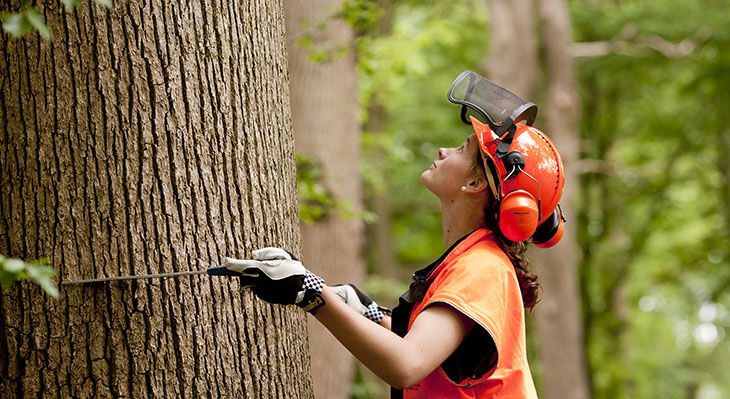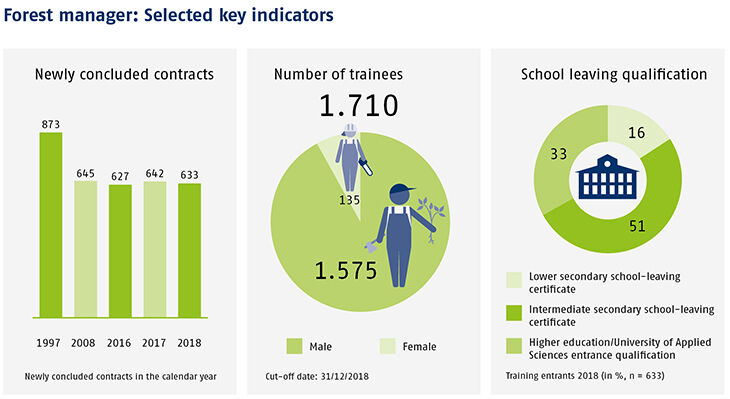Profile of an occupation – forest manager
The consequences of climate change are exerting a major influence on vegetation and are changing the face of our woods and forests. All forest tree species have suffered as a result of the extremes of weather experienced over recent years. Instances of damage caused by heat, storms and pests such as the bark beetle are increasing. At the same time, our awareness of woodland as a place of recreation is growing. This draws attention to the occupational profile of forest manager, a field in which requirements are becoming ever more extensive and complex.

Managing and protecting our woodlands and forests
The training occupation of forest manager goes back to initial regional regulations from the 1950s and 1960s governing the tasks performed by skilled forestry workers. In 1974, nationally standardised training leading to the qualification of forest manager was created on this basis.
The tasks contained within this occupation cover the aspects of sustainability, nature conservation and environmental protection and are thus highly diverse. Forest managers do not merely manage the forest. They are also responsible for supplying the wood which provides raw materials for many branches of trade and industry and for the felling of trees. The latter also includes the measurement, sorting and storage of wood. Protecting woodland against pests and rejuvenating and establishing forest stocks are further typical tasks. They take care of benches and signposts and maintain forest pathways in a good condition so that hikers and walkers are able to find their bearings and have an enjoyable experience.
Forest managers tend to work for forestry companies. They may also be employed in horticulture and landscape gardening, at national parks or in related areas such as nature conservation. Improvements to procedures and technology have made working in the forest easier and are reducing the potential strains on health. Nevertheless, this is an occupation in which physical exertion is required. Work also largely takes place outdoors. The number of entrants to the occupation of forestry manager has remained relatively constant over the past three years, during which time an average of 634 new training contracts have been concluded annually (cf. Figure).
Trends
Both climate change and digitalisation are altering and adding to the requirements made of forestry occupations. New technologies for the timber harvest and for damage documentation are able to support forestry managers in their work.
Drones in the forestry sector
The developments in drone technology and in the sensors used in this area are offering new opportunities for the efficient management of forests and woodlands. Camera drones are capable of recording the damage caused by storms or forest fires and can also recognise beetle or fungal infestations. In order to be equipped to deploy such technology, skilled workers need to acquire the relevant knowledge and expertise.
Sustainability and biodiversity
These two terms have attracted greater public attention within the context of climate change and the loss of species. Woodlands and forests are key to the stability of eco-systems, and there is a close correlation with biological diversity in this regard. Forestry managers thus bear increased responsibility for the retention, protection and development of special natural habitats.
Women in forestry
Statistically speaking, women still very much make up a minority of workers in forestry occupations. Indeed, the proportion of female trainee forestry managers in 2018 was only around eight percent (see Figure). The demanding physical nature of the work is certainly also a factor in this respect. Nevertheless, the deployment of forestry machines has become an indispensable part of the timber harvest. But although the range of different types of machine continues to expand, there is also shortage of trained specialist staff to operate them. The Association of German Foresters believes that continuing training leading to the qualification of forestry equipment operator represents a particularly attractive professional route for women.
Special term: Pruning for quality
The purpose of pruning for quality is to improve the condition of the wood of tree trunks by keeping them clear of knots. This then increases the sale price that can be obtained. Some species of tree do not easily shed their dead branches and thus cannot self-cleanse effectively. In such cases, a special technique is used to remove branches in the area of the trunk whilst the tree is still young. The idea here is to prevent ingrowth. Pruning for quality is carried out in the lower part of the tree only. The live crown should still account for at least 40 percent of height.
Career options
Numerous continuing training opportunities are available to forestry managers upon completion of initial vocational education and training. These include master craftsman in forestry management, forestry technician, forestry equipment operator and agrarian specialist in tree management and maintenance. It is also possible to proceed to a higher education course of study in forestry management or forestry science if the relevant entry requirements are fulfilled.
At a glance
- Occupation last updated: 1998
- Duration of training: 3 years
- Responsibility: Agriculture
- Training structure: Mono occupation
- DQR reference level: 4
- Association of “Women in Forestry”: https://forstfrauen.de
- BIBB website page on the occupation: www.bibb.de/de/berufeinfo.php/profile/apprenticeship/0621101_
(Compiled by Arne Schambeck)
Sources: Hauptverband Papier- und Kunststoffverarbeitung e.V. [Main Association of the Paper and Plastics Manufacturing Industry], Fachverband Faltschachtel-Industrie [Association of the Folding Box Industry], “Berufenet” Portal of the Bundesagentur für Arbeit [Federal Employment Agency]
Translation from the German original (published in BWP 2/2020): Martin Kelsey, GlobalSprachTeam, Berlin
